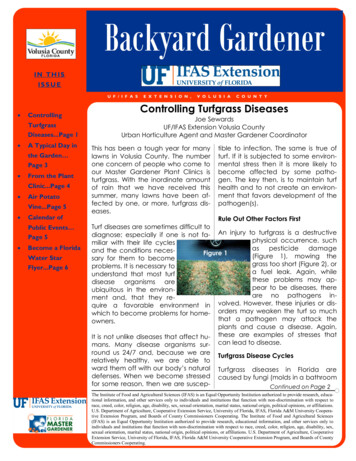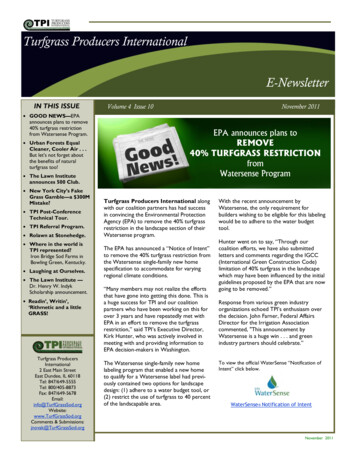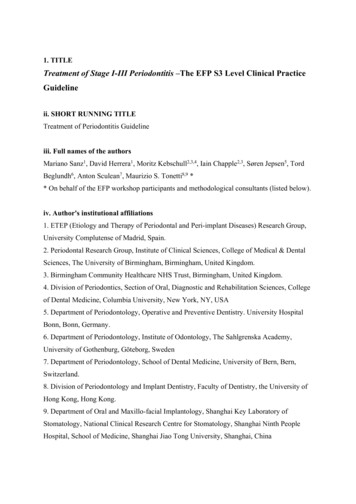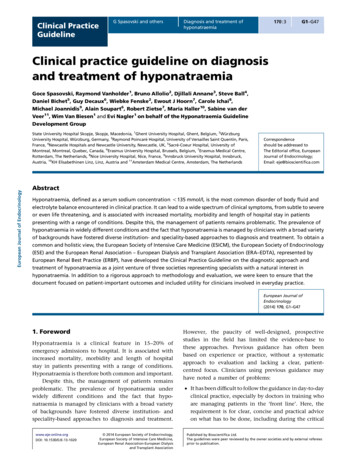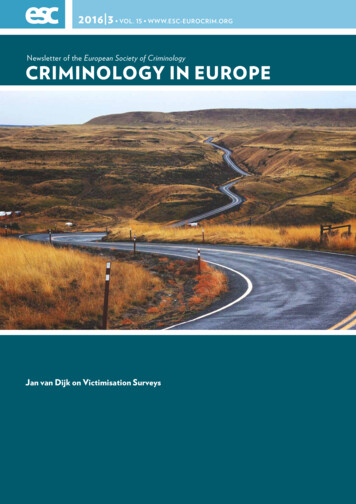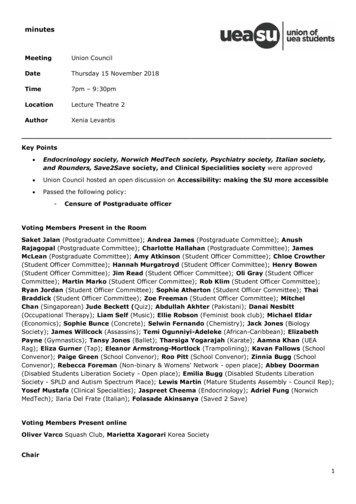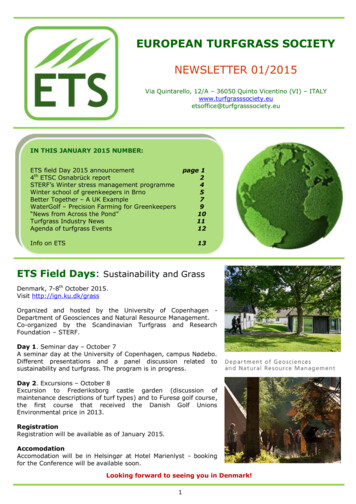
Transcription
EUROPEAN TURFGRASS SOCIETYNEWSLETTER 01/2015Via Quintarello, 12/A – 36050 Quinto Vicentino (VI) – iety.euIN THIS JANUARY 2015 NUMBER:ETS field Day 2015 announcement4th ETSC Osnabrück reportSTERF’s Winter stress management programmeWinter school of greenkeepers in BrnoBetter Together – A UK ExampleWaterGolf – Precision Farming for Greenkeepers“News from Across the Pond”Turfgrass Industry NewsAgenda of turfgrass Eventspage 124579101112Info on ETS13ETS Field Days: Sustainability and GrassDenmark, 7-8th October 2015.Visit http://ign.ku.dk/grassOrganized and hosted by the University of Copenhagen Department of Geosciences and Natural Resource Management.Co-organized by the Scandinavian Turfgrass and ResearchFoundation – STERF.Day 1. Seminar day – October 7A seminar day at the University of Copenhagen, campus Nødebo.Different presentations and a panel discussion related tosustainability and turfgrass. The program is in progress.Day 2. Excursions – October 8Excursion to Frederiksborg castle garden (discussion ofmaintenance descriptions of turf types) and to Furesø golf course,the first course that received the Danish Golf UnionsEnvironmental price in 2013.RegistrationRegistration will be available as of January 2015.AccomodationAccomodation will be in Helsingør at Hotel Marienlyst - bookingfor the Conference will be available soon.Looking forward to seeing you in Denmark!1
4th ETS Conference 2014 Osnabrueck, Germanyby Claudia de Bertoldi, ETS Communications ManagerEvery two years, ETS runs its scientific turfgrass conference in one of its member countries, to promotethe exchange of information among turfgrass specialists from universities, official bodies and privatecompanies. Following Italy, France and Norway, Germany has been chosen to host the event in 2014. TheUniversity of Applied Sciences organized and hosted the 4 th ETS Conference 2014 in Osnabrueck from 6th –9th July 2014.The Organising Committee with Prof. Martin Thieme-Hack as convener superbly prepared this internationalcongress in collaboration with the German Turf Society (Deutsche Rasengesellschaft).The conference keynote theme was: “Balancing turfgrass performance and sustainability” and, as in pastyears, the focus of the congress lied on discussion of the latest research results in the area of turfgrass inits most diverse manifestations from institutions in Europe and overseas, especially in North America.Works opened on the morning of 7th July with a welcome from the Organizing Committee, followed byinvited speaker talks by Ursula Eid (Osnabrueck University), Rüdiger Prasse (Leibniz University Hanover)and Martin Thieme-Hack (Osnabrueck University). After a coffee break followed the session on “TurfgrassSpecies and Breeding” chaired by Scott McElroy of Auburn University, while lunch preceded the session on“Soil and Water Management” (Chairman Bernd Leinauer of NMSU).The ETS General Assembly was chaired by Prof. Charles Peacock (NCSU) and saw the presentation of2013-2014 activities and balance by ETS President Panayiotis Nektarios (Athens Agricultural University)and newly-appointed ETS Secretary Filippo Lulli (Turf Europe).The first day was closed by a welcome outdoor visit in the German summer to the turfgrass field trialssetup expressly for the ETSC at Osnabrueck University, followed by a exquisitely organized outdoorbarbecue.The following day saw intense Conference activities carry the participants through sessions on “TurfgrassDiseases, Pests and Weed Control” (Chair Marco Volterrani, Pisa University), “Turfgrass for Golf and SportsFields (Chair Filippo Lulli, Turf Europe), “Turfgrass growing factors, Impact for the Environment (ChairWolfgang Praemassing, Deula Rheinland) and “Turfgrass Nutrition and Physiology” (Chair Trygve Aamlid,Bioforsk).The day closed with an eventful dinner and evening at Steigenberger Hotel Remarque, where guests weretreated to a great dinner accompanied by an enjoyable show staged by the Drama students of OsnabrueckUniversity, not to mention witnessing a memorable football exploit by the German national side soundlybeating the home team of Brazil at the FIFA World Cup semi-final. Needless to say chilled German beerflowed and streets were alive with festive supporters until the early hours of the morning.The last day saw the perfectly organized Turf Tour take the participants to the DSV-Eurograss BreedingStation in Asendorf to see the turfgrass breeding nursery and the plots for turfgrass mixtures and varietytesting, followed by lunch offered by DSV. In the afternoon ETSC participants were taken on a visit of theGolf Course in Achim and the famous Weserstadium in Bremen where Bundesliga side Werder Brema playtheir home matches.2
On the whole 110 delegates from 17 differentstates on three continents attended the ETSC,with a welcome mix of academics,practitioners and turfgrass industry delegates.ETS has developed two categories ofpapers/posters, that are published in twooffprint publications: Scientific publications, published in thewidely-indexed European Journal ofHorticultural Science (EJHS). Technical publications, published as theETSC Proceedings on the European Journal ofTurfgrass Science (EJTS).All publication abstracts can be downloadedhere: www.turfgrasssociety.eu/home/articles3
STERF’s Winter stress management programmeby Maria Strandberg1 and Tatsiana Espevig21STERF – Scandinavian Turfgrass and Environmental ResearchFoundation, Sweden2Bioforsk Turfgrass Research Group, Norway & STERF sk.no and maria.strandberg@golf.seIt is apparent that the golf and turf grass industry faces anumber of local and international challenges, all of which willneed concerted and collective solutions, underpinned by robust,applied science. To meet the challenges the sector has to face,the Scandinavian Turfgrass and Environment ResearchFoundation (STERF) has created four international and transdisciplinary Research and development (R&D) programs,including: Sustainable water managementTurf grass winter stress managementIntegrated pest managementMultifunctional use of golf facilitiesThe programmes are created in close collaboration with the golfand turfgrass industry.Progress in these programme areas will collectively lead toimprovements in the quality of managed turf grass areas as wellas economic and environmental gains for the industry. The keyobjectives of the programmes are to coordinate design andrunning of R&D activities, and to coordinate effectivedissemination of the resulting new knowledge through channelsand formats that are easily accessible to end-users. STERF willplay a key role in expanding the programmes on aninternational level. All four STERF R&D-programmes can befound at: http://sterf.golf.se.The programme within Turf grass winter stress managementwas published early 2014 and is a joint R&D programmebetween STERF and Canadian Turfgrass Research Foundation.Winter damage is the foremost reason for dead grass in theNordic countries, reducing the aesthetic and functional value ofturf. UN-IPCC climate scenarios predict that due to highprecipitation and unstable temperature, ice and water damagewill become the most important cause of winter damage in thefuture. The programme within winter stressmanagement defines winter stress management as ‘All actionstaken to prepare the plant for the winter, avoid winter-relateddamage and re-establish high quality turf in the spring’. This is acomplex but high priority area for STERF, as it has beenestimated thatabout 70% of Nordic golf courses suffer from winter damageevery year, and that the associated average annual costs pergolf course are 35,000-40,000. The programme was created bya STERF appointed committee consisting of Agnar Kvalbein(leader), Tatsiana Espevig, Wendy Waalen and Trygve S. Aamlidfrom Bioforsk Turfgrass Research Group.To provide inputs and assure the scientific quality and practicalrelevance of the programme, the committee received assistancefrom an international reference group consisting of researchers,consultants and practitioners from Canada, Iceland, Sweden andFinland.4
Winter School of greenkeepers was held at Mendel University successfullyby Stanislav Hejduk, Mendel University in Brno, Czech RepublicTraditionaltwo-dayeducational seminar forgreenkeepers, studentsand others interested inturfgrasses held in thecampus of Faculty ofHorticulture in Lednice(10 km from the borderwithAustriaandSlovakia), which is partof Mendel University inBrno. The term of theseminar was December4th and 5th 2014. Theseminar was attendedby over 50 participantsmainly from the CzechRepublic but also fromSlovakia, Austria andeven from Slovenia.Seven lectures werepresented (5 foreignand two Czech) whichwere supplemented bynewexperiencesofCzech greenkeeperswith cyanobacteria. The welcome speech was presented by vice dean of the Faculty of Horticulture Dr.Tomáš Nečas who had familiarized the attendants with history of faculty and its research and educationactivities.At the outset of the seminar greenkeepers Kamil Pečenka and Jiří Kapeš presented problems that they hadsolved on their greens. Grass in the spots turned in purple colour, halted the growth and ignores thenitrogen application. After microscopic examination a high incidence of cyanobacteria Phormidium revealed.They were present even in the vascular bundles of grass leaves, where they apparently got through cutwounds after mowing. On the other greens they created a large amount of unpleasant slime.The name of the first lecture was therefore Cyanobacteria and algae on golf courses – problems,applications. The lecturer was Dr. Tomáš Hauer from the University of South Bohemia, Czech Republic. Hesaid to the present audience that algae and cyanobacteria were spread through the air and therefore it wasimpossible to eliminate the source of infection. If they occur in the irrigation ponds, the water is not asource of contamination, because cyanobacteria and algae living in water have different environmentalrequirements than those living in soil and turf.Prof D.M. Kopec (University of Arizona, USA) presented problems of recycled water use for turfgrassirrigation and activated biosolids used as turfgrass fertilizers. He warned, that recycled water contain notonly many plant nutrients, but also salt (sodium chlorine), which can be harmful for physical properties ofsoil. Activated Biosolid are in the USA fortified by synthetic auxins which enhance turf vigour. The lastlecture of professor Kopec was aimed to genetics of Poa annua. Different ways how to control the presenceand heads formation of this grass in golf greens by herbicides and plant growth regulators were introduced.He also described the differences between annual and perennial biotypes and noticed that it was notpossible to breed stable perennial varieties of this grass. This species behaves unlikely from other grassesand can switch its genotype in few generations according a given environment.Chairman of Slovenian Greenkeepers Association Darko Cecelja presented Slovenian greenkeeping andmany educational activities of the society. It is very surprising that so small country is able to organizemany seminars and travel to the USA to get new knowledge and inspirations.Dr. Jaroslav Martínek (Syngenta, Czech Republic), who defended his PhD thesis in turfgrass science,introduced current problems with pesticides registration and described how to face a new threat ofpesticides audits on golf courses executed by government bodies recently.5
Dr. C. Spring (STRI Bingley, UK) introduced his main area of interest in the title of the first lecture: ITM:Don’t forget the soil. With respect to his background, which is focused to soil science, he emphasised, thatgreenkeeper should be at the same time also a soilkeeper. Content of soil organic matter in greens shouldbe evaluated regularly for adjustment of aeration measurements and the frequency of top dressing withsand. Sometimes turf aeration can be just waste of time and money. In his second lecture Integratedturfgrass management: Long-term evaluation of playing surfaces he introduced an instrument for testing ofgreens trueness and smoothness (STRI trueness meter). He described also a measurement of otherparameters as firmness (Clegg soil impact tester), penetration resistance, infiltration rate and soil moisturecontent of surface layers using Theta probe.Last presentation was focused on weeds control in turfgrass and was presented by an independentconsultant Dr. Giovanni Tracanzan from Italy. The most important statement was that it has not yet beenfound any practical alternative to the use of synthetic herbicides and biological and mechanical control ofweeds is not sufficiently effective. He described a detailed strategy to regulate annuals C4 grasses(Digitaria sanguinalis, Setaria viridis and Echinochloa crus-galli) using a combination of both pre- and postemergence herbicides. Unfortunately, these products are not registered for use in turfgrasses in the CzechRepublic and in neighbouring countries. With climate warming these weeds becomes increasing issue alsoin Central Europe.The seminar was a success for both the professional and social site and due to the long lasting, but fruitfuldebate it was not possible to present all scheduled contributions. Most participants expressed interest inparticipating in next year's seminar again.6
BETTER TOGETHER – A UK EXAMPLEby Prof. JohnAmenity Forum.Moverley,ChairmanoftheThis brief article provides information on theway all involved in the UK amenity sector areseeking to work together to promote bestpractice in weed, pest and disease control. Theyseek to voluntarily respond to changes and byso doing stay in control. It also introduces a newinitiative seeking to promote research andimportantly its practical applications in managedamenity grassland.The impact of the UK’s implementation of boththe Sustainable Use and Water FrameworkDirectives is significant and affects everyone inthe amenity sector and certainly all thoseinvolved in sports turf. It requires everyone todemonstrate that they are operating at bestpractice levels and adhering to the correctstandards.In the UK, the Amenity Forum is the voluntaryinitiative established to promote best practice inall aspects of weed, pest and disease control.It is funded by the sector and embraces in its membership all the various representative organisations aswell as manufacturers, distributors, contractors, local authorities, utilities – in fact all who have an interestin the sector. It seeks to demonstrate that the sector working together is best placed to respond to changeand is committed to high standards. This approach is far better than leaving it to external agencies todictate change. The Forum is recognised by the UK Government and undertakes its work through guidancematerial, updating events, its important annual conference and exhibition and through dialogue withprincipal stakeholders and external agencies. It has a part time independent chairman and secretary but, inthe main, relies on each of its members providing resource and timer to make a difference.To date, its achievements have been considerable and impact great. However there still remains much tobe done and still many in the sector who need to get more engaged. Just as change is constant so is theneed for the Forum to keep on developing and evolving.In the remainder of this article we will look at just a few of the Forum activities but ones of real relevanceto turfgrass.The Amenity Forum has produced a series of guidance notes covering a wide range of topics. They arebased upon the Ten Golden Rules, a document produced by the Forum in conjunction with the GovernmentAgency, the Chemicals Regulation Directorate. If everyone follows the Golden Rules, then they demonstrateadherence to very best practice. These rules and all guidance notes are available on the Forum’s websitewww.amenityforum.co.uk and are promoted as essential reading for everyone involved in the sector at7
whatever level. The Forum is also active in promoting the Amenity Assured Standard. This award isexternally verified by BASIS Registration and through its acquisition, organisations can fully demonstrateadherence to the highest standards. It remains voluntary but in the UK more and more awarders ofamenity contracts are seeking the standard. The Forum is currently engaged in an initiative with the BritishInternational Golf Greenkeepers Association (BIGGA) seeking to develop specific guidance for greenkeepersso they can operate to Amenity Assured levels. It is very important that we can all demonstrate that weare operating at this level. If we work together and show that voluntarily we can drive up standards, itmeans that we can argue strongly against further changes or restrictions which may impede our ability tomaintain current standards of performance.In the first few months of each year, the Amenity Forum holds a series of updating events in a number oflocations across the UK. These are free half day events when current topics such as policy change,integrated control, professional development and related items are presented and discussed. These are alldirectly relevant to those involved in the turf grass sector. They are hosted by member organisations andalso receive sponsorship support. They are important in taking out the message and ensuring the sector isworking together.A key element of the UK National Action Plan established in the wake of recent implementation of theDirectives is the need for all to take an integrated approach. . Before addressing weed, pest and diseasesproblems, it is important to consider all the control options available and make appropriate use of them tomaximise effectiveness and efficiency. Integrated planning seeks to minimise risks and achieve requiredcontrol by adopting the right approaches to suit specific situations. In seeking to further advance such anapproach, the Amenity Forum is working with other key stakeholders across the turf grass sector toestablish a research foundation for managed amenity grass. The aim is not only to support further researchbut importantly seek out ways for improving communication and application of research findings andoutcomes at practitioner level.Over the next months, the Forum is rolling out a series of new initiatives including its new Sprayer OperatorAwards with a specific sports turf category and a new improved continuing professional developmentscheme. The latter is managed by BASIS Registration and seeks to be very flexible. It will recognise a widevariety of training including in house and that on other CPD schemes. Currently uptake on CPD for pest,weed and disease control is somewhat below par in the UK amenity sector and this scheme seeks to helpimprove the position. The Forum is also seeking to strengthen links with other European partners. . We arebetter together.In the UK, we can be rightly proud of the quality of our sportssurfaces and the skilled staff who make them so. An essentialelement of this is the need to control weeds, pests anddiseases. It is important that we maintain the higheststandards and keep fully updated. One way to do this is fororganisations to join the Amenity Forum to demonstrate theircommitment and further increase their lobbying power. Todate this approach has proved extremely successful. Perhapsthere is opportunity for a European Amenity Forum?For further information about the Forum or its activities andto be included in its newsletter circulation, visit the website orcontact Alan.Spedding@amenityforum.co.uk8
WATERGOLF: Wireless distributed intelligent system forirrigation optimisation and early turf disease prevention andtreatment on golf coursesby Filippo Lulli PhD, Turf Europe.Water is perhaps the single greatest challenge to golf’s sustainability. Arecent report from the European Environment Agency (EEA) revealedthat Europe has so far concentrated on increasing the supply of waterrather than exploring ways to limit its demand, and recreational watertakes up a growing percentage of total water use. Golf courses,especially in drier regions, are often targeted as using excessiveamounts of water and some governments have labelled golf courseusage as agricultural in order to deflect environmentalists charges ofwasting water. The Golf sector has therefore been looking to find waysfor optimizing its water consumption by increasing efficiency and usinginnovative technologies as this also makes good economic sense, sincewater costs will most likely rise in the near future. With this in mind, apool of companies with financial support from the EC has developedWaterGolf: an innovative precision farming system to a) aid inscheduling and optimizing irrigation, b) predict the onset of fungaldiseases and c) forecast the germination of common golf course weeds.WaterGolf is wireless system capable of optimizing irrigation on golfcourses and promises to aid greenkeepers in obtaining better-cared forgreens and fairways and substantial savings in water usage as well. Infact, the EU-funded WaterGolf project, which kicked off in January 2013,could end up saving golf courses one third of their annual water budget.WaterGolf will also aid greenkeepers in supplying a forecast for thedevelopment of fungal diseases and weeds, together with an imageprocessing tool, to advise the greenkeeper on the actions to take inorder to maintain the course in top condition.How is this achieved? By integrating underground sensors capable ofmeasuring underground humidity, salinity and temperature along withsurface sensors to measure colour, wind speed and direction, andevaposensors to measure turf water consumption, the system willgreenkeepers with substantial and easy-to-use advice in the form of a)number of hours before estimated water stress, b) amount of water tobe reintegrated in the soil or substrate, c) fungal disease alarms andrelated chemical treatments to be carried out, d) select weedgermination alarm.The system will work by feeding regularly updated measurements viawireless technology into artificial intelligence-driven software. Thissoftware will then suggest parameters for irrigation in different areas ofthe course, taking into consideration other inputs such as 3D golf coursemapping, drainage and weather forecasts.All measurements will be transmitted by means of low energy consumption ZigBee technology, with abespoke antenna design. ZigBee is used in applications that require a low data rate, long battery life, andsecure networking. The decentralized nature of this wireless ad hoc network makes it suitable forapplications where a central node can’t be relied upon, such as coverage over a golf course.The WaterGolf system is directed towards a real improvement in golf courses: the technology can also beused to inform the user of any existing or potentially looming turf diseases, thus helping golf courses toremedy any problems quickly and efficiently. WaterGolf users will also have internet access to experts inthe field, should they have any questions.The project, which ran until December 2014, received 1.138.986 in EU funding under grant agreement#315054.More info can be found at: www.watergolf-project.com9
“NEWS FROM ACROSS THE POND”Clemson’s Bert McCartyBest Turfgrass ScientistSelectedasBert McCarty, a Professor of Horticulture Science atClemson University and Seneca resident, washonoured with two top awards by the Crop ScienceSociety of America (CSSA) at its annual conference inLong Beach, California. He has been elected a Fellowof the Society and received the Fred V. GrauTurfgrass Science Award.Fellow is the highestrecognition bestowed by the Society, while the utions to turfgrass science and his impact onthe turfgrass industry. McCarty is the first ClemsonUniversity Professor to receive either award.McCarty also recently received Clemson University’sSuperior Service Award within the Division ofAgriculture.The Crop Science Society of America (CSSA) is aninternational scientific society dedicated to the conservation and wise use of natural resources to producefood, feed, and fibre crops while maintaining and improving the environment.10
TURFGRASS INDUSTRY NEWSNew hybrid grass technology by “Mixto”“Reinforced grass on football pitches is becoming more and more appreciated on the markets becauseof the continual improvement of the quality and the performance of the technology available in theworld”, reports Dr. Camillo De Beni, the turfgrass agronomist consultant for Mixto Company. Heannounced that in Italy the Mixto Company, born of a partnership between two Italian leadingCompanies in their respective fields, Rappo for natural grass and Limonta Sport for artificial grass,has developed an innovative system called Mixto. It is a woven artificial turfgrass mat in which andthrough which natural grass grows and where the “special” artificial tufted fibres, called Max -S, usedto reinforce the sward, are the result of hard R&D work by Limonta. Dr. De Beni claims that Max-Shas a special shape and thickness which guarantee the highest resilience performance you can findtoday from an artificial fibre. The high resilience capacity of the artificial fibres is an important ‘plus’in the reinforced grass market because it means an increase of t he functions of the artificialcomponent in the system: the protection of the crown and the grass leaves and the stabilization ofthe root. Furthermore, he declared that characteristic of the Mixto grass technology is also the highand persistent permeability for roots, water and air of the backing, the mat with the tufted fibres.This means that the natural grass, which grows through the artificial component, is able to produceand develop a deep root system in the root-zone mixture below the surface, ensuring the adsorbingcapacity for nutrient and water, the ability to support and maintain leaves, to promote a quickrecovery of any damage, and to permit the higestuse of football pitches. The system is being used insome important Italian Stadiums and footballTraining Centres and Dr. De Beni mentioned thatfrom the data collected, sport turf usage hasdramatically increased.The Company claims that Mixto is a technologythat can be installed directly on the soccer field,sowing it in loco and using it within 2 or 3months, or which some specialized nurseriescultivate and install on the pitch with big rolls, toensure immediate use.In conclusion, they say that reinforced grassshould not be confused with fully artificialturf. The Mixto system is a ‘natural’ surfacewhich combines wear tolerance, playability,planarity and drainage (if the draining soilfoundation is solid and well-performing).For more information and details, you can visitthe Mixto website - www.mixtosystem.it - whereall the references and the news are supportedwith high quality photos.11
Agenda of Turfgrass EventsWhatWhenWhereInfoBIGGA Turf Management Exhibition20-22 JanHarrogate (UK)http://btme.org.ukTPI 2015 International EducationConference & Field Day16-19 FebSan Diego (CA-US)www.turfgrasssod.orgGolf Industry Show21-26 FebSan Antonio (TX-US)http://www.golfindustryshow.comDemopark Demogolf21-23 JunEisenach (DE)http://demopark.deTPI 2015 Live Show and Tell9-11 JulPortland (OR-US)www.turfgrasssod.orgFlormart9-11 SepPadova (IT)http://www.flormart.itETS Field Days7-8 OctCopenhagen (DK)http://ign.ku.dk/grassETP Farm Tour12-13 OctNewark (UK)http://www.turfgrassproducers.euSALTEX4-5 NovBirmingham (UK)http://www.iog-saltex.comAgritechnica10-14 NovHannover (DE)http://www.agritechnica.comPaysalia1-3 DecLyon (FR)http://www.paysalia.comIf you know of a turfgrass-related event which should be included in the Agenda ofTurfgrass Events, please contact the ETS Newsletter Editor atetsoffice@turfgrasssociety.eu with all relevant details. European Turfgrass Society 2015Edited by Claudia de Bertoldi PhD, etsoffice@turfgrasssociety.euDeadline for submission of material for 02/2015 edition: April 15 201512
The EUROPEAN TURFGRASS SOCIETYThe objectives of the ETS include the spread of innovative applications andencouragement of a holistic view of turf, particularly with respect to itsinfluence on urban and environmental quality. This approach is significant asthe founding members are representatives of a large industry that has globalimportance. We aim to:a) Provide a forum for scientists, consultants, companies and practitioners todiscuss technical issues related to the provision of turf surfaces.b) Spread innovative applications for the benefit of the turfgrass industry,national and local government, and the European public. Encourage a systemsbased approach to the study of turfgrass through multi-disciplinary groupsworking at different levels.c) ETS considers turfgrass knowledge in the broadest sense, including its use insport and leisure, its role in improving urban quality and its importance in themitigation of environmental effects such as soil erosion.d) Develop a strong ethos to promote sustainable, low input systems andsolutions based on the conscious use of non-renewable resources.Current ETS Board of DirectorsPanayiotis NektariosAthens Agricultural UniversityETS PresidentAdriano AltissimoLandlab Studio AssociatoETS Board MemberDr. P.A. Nektarios has receivedhis Ph.D. from CornellUniversity with an expertise onturfgrass management and itsenvironmental impact. His vastexperience on turfgrass science and culture issubstantiated by more than 100 publications inimpact factor journals, international and nationalconferences, university notes and daily press. Hewas the organizer/convener of the 1st and the coconvener of the 3rd International Conference onTurfgrass Management and Science for Sport Fields,under the auspices of International Society forHorticultural Science (ISHS) and the E
"Soil and Water Management" (Chairman Bernd Leinauer of NMSU). The ETS General Assembly was chaired by Prof. Charles Peacock (NCSU) and saw the presentation of 2013-2014 activities and balance by ETS President Panayiotis Nektarios (Athens Agricultural University) and newly-appointed ETS Secretary Filippo Lulli (Turf Europe).



